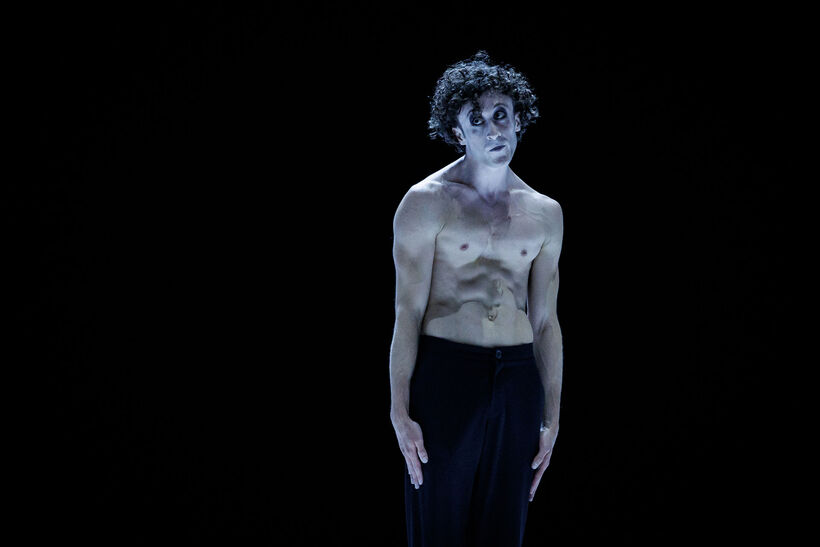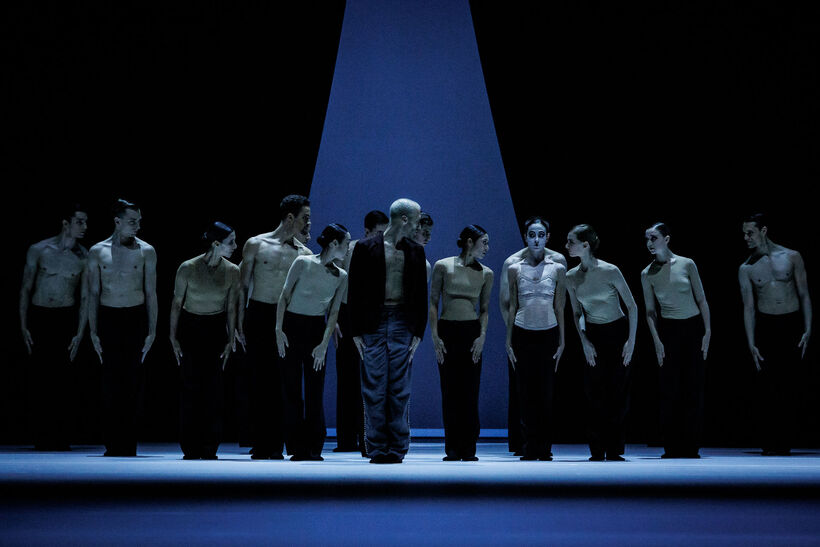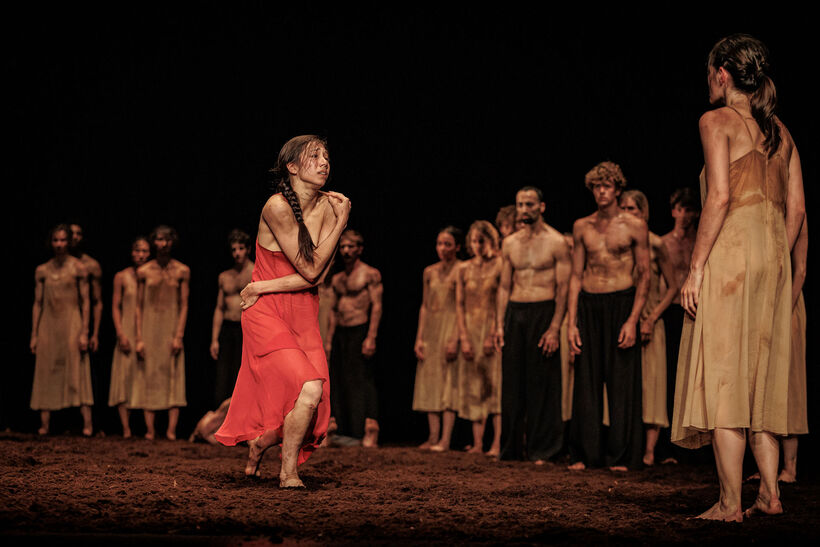Petrushka by Marco Goecke, a 2016 creation for Ballett Zürich, opens the evening’s performances. The original narrative structure of the libretto by Alexandre Benois and Igor Stravinsky is maintained; its story is based on the traditional Russian eponymous character, a puppet with a body made of sawdust and a head of wood, who comes to life and is able to feel. While preserving the narrative, Goecke’s choreographic language is predominantly abstract. It features a series of intertwining solos, duets, trios, with group crossings appearing against the backdrop of a minimalist dark set, which turns the stage into a black box. However, at specific moments, pantomimic and gestural elements enhance not only the meaning of the story, but also its pathos. The ability of the choreographic narrative to elicit total participation on an aesthetic level is certainly achieved by the strategic inclusion of certain elements of street and popular theatre, such as illusion and clown-inspired tricks.
The whole staging is characterised by a sharp lighting design which reconfigures the space, shaping the abstract landscape. The dancers who, as in the original libretto, represent puppets, are dressed exclusively in black trousers, with bare chests (in the case of the male dancers) or with flesh-coloured leotards for the women. Only the figures of the Charlatan (Federico Spallitta) and Petrushka (Alexandre Cagnat) are different, the latter in dark striped trousers, the former wearing an open shirt and burgundy trousers.
Thanks to the effect of the lighting design, the backdrop opens up, creating a circus tent effect to introduce the trio of Petrushka, the Rival, and the Ballerina (Alizée Sicre). As the performance unfolds, it is as if Goecke's choreography were entirely aimed at seeking the corporeal and facial expressiveness of being a puppet, searching not only for Petrushka’s soul, everybody else’s too. Through fragmented, extremely fast and dynamic movements (somewhat typical of Goecke), the dancers’ bodies became machines of expression.

In the strong visual contrast between the black backdrop and the bare skin of the bodies, their faces flamboyantly made up, and in the dichotomy between humour and tragic episodes, the man-puppet abyss becomes ever thinner. The contrast between the minimalist set and expressive faces and sensual bodies make the puppets ‘fleshier’ and closer to humans. And I, as an audience member, empathise with Petrushka with each passing moment.
Goecke uses voice in order to create the effect of estrangement; for example, the character of the Ballerina emits one high-pitched sound over Stravinsky’s score to show excitement. Towards the middle of the piece, Petrushka addresses the audience saying something like “Ich glaube es geht ganz gut heute” (I think it's going quite well today), ironic - since in a few moments he will die.
Following the original story, Petrushka is finally killed by Rival. In fact, his death does nothing but free his soul. A soul that returns to make itself felt to torment those who have hurt it. Goecke's choreographic and theatrical strategy for dealing with this is both entertaining and disturbing at the same time. After being hit by Rival, Petrushka dies, falling sideways, facedown, into the wings on the right hand side of the stage: his upper body backstage, the audience can only see his prone legs stretched out. Surprisingly, shortly after we see him re-enter from the left hand side of the stage, wearing a kind of white Elizabethan collar. He stands still, facing the audience. He smiles with the look of an irreverent but satisfied ghost; thanks to a device in his mouth, his teeth make a mechanical, disturbing chattering sound. It’s enough to send shivers down your spine.

In this choreographic revival, the intelligence and poetic nature of the piece is crystal clear. The narration of Petrushka’s story is made comprehensive thanks to wide-ranging theatrical and choreographic devices. Goecke's Petrushka tells of unfulfilled love, the cruelty of misunderstanding and suffering, and does so with an atrociously light spirit. By intersecting abstract and circus elements, pantomime and clowning, this work reaffirms the potential of dance to reread ancient stories and make them absolutely topical.
The Rite of Spring as a living archive
The next piece is introduced by a scene change with the curtain open. A numerous group of technicians pour a large amount of soil onto the Staatsoper stage to recreate the original The Rite of Spring setting. In this coordinated action of choreographing the soil, they activated a process of perceptive and visual passage from Petrushka’s minimalist void to the now very concrete and recognisable setting of Bausch's iconic Rite. This open stage change, which also received warm applause, brought us back to craftsmanship, directly showing all the work that goes into the final result of a performative event. A reminder that, in addition to the bodies of the dancers, a piece of theatre is made up of many other different bodies, such as those of the technicians.

The Rite of Spring (1975) by Bausch follows the original conception of Stravinsky's musical composition while eliminating any references to pagan Russia. However, she does depict a dramatic vision of the passage to the spring as a sacrificial ritual, represented by a red dress that is passed from hand to hand between the dancers, until it lands with The Chosen One, who wears it while dancing towards her death.
Through expanded ports de bras, bending of backs that almost touch the floor, grips, contraction, and contact with the ground, Rite by Staatsballett strikes straight to the heart. The ability of the entire corps de ballet to fully assimilate Bausch’s movement language makes the choreography personal, contemporary even.

These vibrant bodies, through their movement and breath, are fully capable of conversing with a piece from the 70s. Through the frame of highly classic academic training, but without exposing it, Rite has a new, different, beautiful life. The great work of the six members of the Bausch Foundation, responsible for this staging and the dancers who accepted this challenge shows the extent to which re-framing a training generates the possibility to increase and channel individual expression into a specific choreographic experience. Thanks to these bodies capable of turning an old piece into a current one, The Rite of Spring regains new strength: the choreographic transmission becomes not only an exercise and copyright issue but also and above all it still has creative potential. This means that there is hope for the future of the transmission of non-academic languages, showing that it is possible to keep bodily knowledge alive over time, making the concept of a living archive for the present a reality.
Written from the performance of the 14th June 2023 at Staatsoper Unter den Linden (Berlin).
Stravinsky
Petrushka
Music: Igor Stravinsky
Choreography: Marco Goecke
Stage and costume design: Michaela Springer
Lighting design: Udo Haberland
Dramaturgy: Michael Küster
Staging: Nicole Kohlmann
Musical direction: Giuseppe Mentuccia
Staatskapelle Berlin
Petrushka: Alexandre Cagnat
Charlatan: Federico Spallita
Rival: David Soares
Ballerina: Alizée Sicre
Dancers of the Staatsballett Berlin
The Rite of Spring
Music: Igor Stravinsky
Staging and choreography: Pina Bausch
Stage and costume design: Rolf Borzik
Collaboration: Hans Pop
Artistic head of staging 2023: Azusa Seyama-Prioville
Staging: Scott Jennings, Thusnelda Mercy, Jorge Puerta Armenta, Kenji Takagi, Anna Wehsarg, Tsai-Chin Yu
Musical direction: Giuseppe Mentuccia
Staatskapelle Berlin
Dancers of the Staatsballett Berlin








